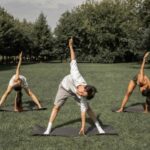The flexibility box test, commonly known as the sit and reach test, is a widely used measure of lower back and hamstring flexibility. It involves a simple but effective assessment where individuals reach forward while seated, often using a box and ruler for measurement. The test’s origins date back to 1952 and since then, it has been incorporated into various fitness assessments due to its reliability and ease of administration. The flexibility box test serves as a benchmark to gauge an individual’s baseline flexibility and to monitor progress over time.
Various adaptations of the test exist to accommodate different populations and circumstances. For example, the Back-Saver Sit and Reach protocol tests each leg individually, enhancing its relevance for individuals with discrepancies in flexibility between limbs. There is also a modified version for the elderly, known as the Chair Sit and Reach Test, which is performed while the individual is seated on a chair, promoting safety and accessibility.
In administering the test, participants sit on the floor with extended legs and reach forward as far as possible over a specially designed box. The distance reached by the hands beyond the toes or to the point on the box is measured, providing an objective score of flexibility. While it predominantly focuses on the lower back and hamstrings, performance on the test can also reflect general flexibility and has correlations with overall physical health.
Understanding Flexibility and Its Importance
Flexibility plays a crucial role in physical fitness, enabling a full range of motion and contributing to overall well-being.
Defining Flexibility
Flexibility refers to the capacity of the joints to move through their full span unimpeded. It is a component of physical fitness that pertains to the ease with which one can bend, stretch, and twist. Adequate flexibility is necessary for the performance of everyday activities and is characterized by the ability of the muscles and tendons to elongate in response to movement.
Benefits of Flexibility in Fitness
Enhanced Physical Performance: Individuals with optimal flexibility can perform functional movements with greater efficiency, which is beneficial in athletics and daily life.
- Injury Prevention: Maintaining flexibility helps guard against injuries by preparing muscles and joints for the stress of physical activities.
- Improved Posture and Balance: A flexible body maintains better posture and balance, decreasing the likelihood of falls and the strain on the musculoskeletal system.
- Relieves Muscle Tension and Soreness: Regular flexibility training can lead to reduced muscle tension and may alleviate soreness after exercising, promoting faster recovery.
Being flexible is not just about achieving impressive stretches; it is a fundamental aspect of physical health that affects an individual’s capacity to live an active, injury-free lifestyle.
Flexibility Assessment Techniques
Evaluating flexibility is essential for understanding an individual’s range of motion and identifying areas that may need improvement. Two principal methods are widely acknowledged: the sit and reach tests and various alternative flexibility tests.
Sit and Reach Tests
The sit and reach test is famously known for its straightforward approach to assessing the flexibility of one’s hamstrings and lower back. Individuals perform this test by reaching forward while sitting, either using specialized equipment, like a sit-and-reach box, or a basic tape measure for at-home versions. Validity and reliability make it a popular choice for all fitness levels.
- Standard Sit and Reach: Participants sit with extended legs and reach forward along a measuring apparatus, marking their reach distance.
- Back-Saver Sit and Reach: This adaptation involves reaching forward with one leg extended and the other bent to prevent strain on the back.
- Modified Sit and Reach Test: For those with back or hamstring concerns, a chair may be used to perform a variation of the test.
- V-Sit Reach: In this variant, the individual sits on the floor with legs forming a “V” and reaches forward.
Alternative Flexibility Tests
While the sit and reach is predominant, alternative methods using tools like the goniometer are also employed for more specific joint flexibility assessments.
- Goniometry: Involves the use of a goniometer to accurately measure the angle of joint flexibility, offering a precise quantification for individual joints.
Additional tests that don’t rely on a sit-and-reach box include:
- Shoulder Flexibility Tests: Using a stick or bar, individuals assess their shoulder flexibility through various movements such as over-the-head lifts and behind-the-back reaches.
- Back Scratch Test: A measure of upper body flexibility where one hand reaches over the shoulder and the other up the back to touch fingers.
Each technique provides insights into different aspects of an individual’s flexibility, contributing to a comprehensive assessment.
The Sit and Reach Box and Its Usage
The sit and reach box is an essential tool for evaluating lower back and hamstring flexibility through a standardized testing procedure. Proper use and understanding of its components are crucial for accurate sit and reach test results.
Components of a Sit and Reach Box
A sit and reach box typically consists of a solid base with a built-in ruler extending from the top surface. Here’s a breakdown of the key components:
- Base: A box approximately 30cm in height that serves as the starting point for measurements.
- Ruler: A meter stick is affixed on top of the box; it should begin at the 26cm mark and extend forward, allowing the person being tested to reach along its length.
Setting Up the Sit and Reach Test
To set up the sit and reach test, one must position the box and ruler properly:
- Place the sit and reach box flat against a wall.
- The subject sits with their feet flat against the box.
- The ruler’s start point will be level with the feet, typically set such that the 26cm mark on the ruler is at the edge of the box facing the participant.
The procedure involves the following steps:
- Participants warm up prior to the test.
- With legs straight, the participant leans forward slowly, pushing a marker along the ruler’s length.
- Performance is indicated by the most distant point reached; the test is commonly repeated three times for consistency.
These guidelines help ensure the sit and reach test is administered effectively, providing reliable assessments of flexibility.
Evaluation of Flexibility Tests
Flexibility tests are essential in assessing the range of motion and mobility in various joints and muscles. These assessments can identify potential areas of restriction and assist in charting progress over time.
Reliability and Validity
Reliability refers to the consistency of a test’s results upon repeated administration. For the sit and reach test, a common flexibility test, studies have demonstrated it to possess both high intratrial and test-retest reliability, making it a dependable measure of flexibility over time.
- Intratrial reliability pertains to the consistency of results within the same testing session.
- Test-retest reliability measures the stability of test results across different testing occasions.
Validity reflects how well a test measures what it is intended to measure. The sit and reach test has been validated as an effective measure of hamstring, hip, and lower back flexibility.
- Concurrent validity is established when the test outcomes correlate well with those of a recognized gold standard test.
- It’s important that a flexibility test specifically measures the flexibility of relevant muscle groups without being unduly influenced by other factors.
Interpreting Normative Data
When interpreting the flexibility scores from tests like the sit and reach, it is crucial to reference normative data. This data provides a context by comparing an individual’s score against a population’s scores.
- Norms should be age- and gender-specific.
- For example, normative data for the sit and reach flexibility test can help determine whether an individual has above average, average, or below average flexibility within their demographic.
- It’s also worth noting that while norms offer a comparison, individual factors such as genetics and activity level should be considered for a comprehensive analysis.
By referencing both reliability and validity data, alongside normative scores, practitioners can confidently interpret flexibility tests to inform health and exercise decisions.
Role of Warm-Up Before Flexibility Testing
The role of warm-up prior to engaging in a flexibility test is critical in preparing the body and enhancing the accuracy of the results. Warm-up routines typically involve light cardiovascular activity followed by stretching, which can improve range of motion and potentially influence flexibility testing outcomes.
Dynamic Versus Static Stretching
Dynamic stretching refers to the active movement of muscles to bring forth a stretch but not holding the position for long. It progressively increases the range of motion and body temperature, preparing the muscles for the flexibility test. Dynamic stretches mimic the movements of the activity or sport to come, which, for a flexibility test, means preparing the joints for the range of motion required during the assessment.
Static stretching, on the other hand, involves holding a stretch for a prolonged period, typically 15-30 seconds. Static stretching targets the muscles’ length and can establish a baseline flexibility level. However, it’s important to note that overdoing static stretches before testing may affect performance, as muscles can become too relaxed, leading to less dynamic range of motion during the test itself.
Influence on Test Outcomes
A proper warm-up influences flexibility test outcomes by:
- Elevating Muscle Temperature:
- Increases muscle elasticity.
- Decreases the risk of injury.
- Improving Baseline Range of Motion:
- Provides a more accurate assessment of flexibility.
- Highlights improvements or the need for further development.
The warm-up should be tailored to the type of flexibility test being conducted. Some tests may specify whether a warm-up is required or if the subject should be ‘cold’ to avoid skewing the results. The importance of adhering to the test protocol cannot be overstated, as it ensures the validity and reliability of the test outcomes.
Common Conditions Affecting Flexibility
Flexibility can be significantly influenced by various health conditions and lifestyle factors. Two common factors that particularly impact one’s range of motion are low back pain and the natural changes that occur with aging.
Low Back Pain and Flexibility
Individuals with low back pain often experience a decrease in flexibility, particularly around the lower back region. Pain and stiffness in this area can limit the range of motion, making it challenging to perform movements that rely on lower back flexibility. The link between flexibility and low back pain is bidirectional: poor flexibility can contribute to the development of back pain, while existing back pain can lead to further stiffness.
- Symptoms of low back pain include:
- Muscle aches
- Shooting or stabbing pain
- Pain that radiates down the leg
- Limited flexibility or range of motion of the back
Age and Flexibility Changes
As individuals age, they often experience a natural decrease in flexibility. Age-related loss of flexibility is prevalent across different age groups and can be evident as one moves from childhood into adulthood and onwards into the senior years. Over time, the body’s tissues can lose elasticity, leading to an overall feeling of stiffness and reduced joint range of motion.
- Factors contributing to age-related changes include:
- Degenerative changes in the joints
- Shortening and loss of elasticity in the muscles and tendons
- Reduced natural lubrication in the joints
Understanding these conditions is crucial for developing effective strategies to maintain or improve flexibility, particularly for those undergoing flexibility testing, such as the flexibility box test.
Incorporating Flexibility Training in Rehabilitation
Flexibility training is a vital component of rehabilitation programs, particularly for restoring range of motion and aiding in the recovery of the hamstring and hip regions. Carefully monitored stretching exercises can significantly support the healing process.
Hamstring and Hip Flexibility
Hamstring flexibility is crucial for a successful rehabilitation journey. These muscles play a pivotal role in lower back health and overall mobility. To enhance hamstring and hip flexibility, physical therapists might integrate specific stretches that target these areas, paying particular attention to the safe extension of ligaments and muscles. For instance:
- Hamstring Stretches: Performed with controlled intensity to avoid over-extension.
- Hip Flexor Stretches: Focus on the front of the hip, aiding in reducing tightness.
Proper technique is essential to prevent additional strain, and a warm-up should precede stretching to prepare the muscles and ligaments for the exercise.
Progress and Milestones
Tracking progress is a foundational aspect of incorporating flexibility training in rehabilitation. Objective measures, such as the Sit-and-Reach Test, provide tangible milestones that help both patients and therapists gauge improvements in flexibility. Through consistent assessments, they can establish:
| Milestone | Description |
|---|---|
| Baseline | Initial measurement to set the standard for improvement. |
| Intermediate | Intermediate checks to ensure continuous, gradual progression. |
| Goal | Target flexibility level to signify a successful intervention. |
It’s important to customize flexibility training to the individual’s condition and recovery rate. Adjustments in the regimen are made based on these milestones, ensuring a directed and effective rehabilitation process.
Flexibility Enhancements Over Time
Improving flexibility involves consistent effort and tracking progress through regular testing. A structured approach can lead to significant improvements in trunk flexibility, lower back flexibility, and shoulder extension over time.
Measuring Progression
Endurance Test: An individual’s progression in flexibility can be quantified using an endurance test, which assesses the stamina of the stretch-related muscles. Throughout time, these endurance tests can showcase an increase in an individual’s capacity to hold stretches for longer periods.
Testing Box: Utilizing a testing box during flexibility tests, such as the sit and reach test, provides concrete metrics for tracking improvements in lower back and hamstring flexibility. The distance reached over the box is recorded and compared against previous tests to measure progress.
Setting Achievable Goals
Advantages: Setting short-term and long-term goals has distinct advantages, as it motivates individuals to commit to regular stretching routines and can lead to a meaningful progression in flexibility.
Flexibility Test Videos: They can serve as a helpful resource for setting appropriate benchmarks by demonstrating proper technique and the range of motion to be achieved.
To ensure continuity and effectiveness in enhancing flexibility, one should include tests for shoulder flexibility and the degree of trunk and spine extension within their regimen. Periodic reevaluation using these tools helps in fine-tuning goals to align with an individual’s unique flexibility journey.








